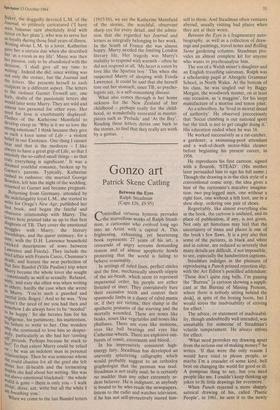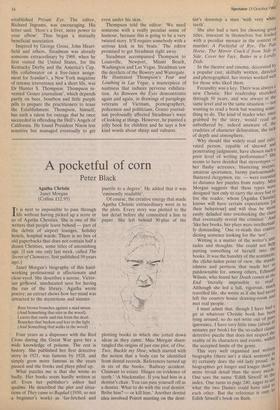Gonzo art
Patrick Skene Catling
Between the Eyes Ralph Steadman (Cape £16, £9.95)
Controlled virtuous hysteria pervades the marvellous works of Ralph Stead- man, a cartoonist who evolved long ago into an Artist with a capital A. This frightening, exhausting yet heartening book represents 27 years of his art, a crescendo of angry screams demanding reason and of almost apoplectic howls protesting that the world is failing to behave reasonably.
In settings of ruled lines, perfect circles and the fine, mechanically smooth stipple of the air-brush, which seem to represent impersonal order, his people are either frenzied or inert. They convulsively bare their excessive teeth and contort their spasmodic limbs in a dance of rabid mania or, if they are victims, they slump in the apathetic postures of the starving and the mortally wounded. There are noses like beaks, noses like vegetables and noses like phalluses. There are eyes like incisions, eyes like ball bearings and eyes like Catherine-wheels. There are explosive out- bursts of vomit, excrement and blood.
In his impressively consistent high- energy fury, Steadman has developed an unevenly spluttering calligraphy which would probably suggest to an orthodox graphologist that the penman was mad. Steadman is not really mad; he is certainly no madder than any other extremely ar- dent believer. He is indignant, as anybody is bound to be who reads the newspapers, listens to the radio and watches television, if he has not self-protectively inured him-
self to them. And Steadman often ventures abroad, usually visiting bad places when they are at their worst.
Between the Eyes is a fragmentary auto- biography, as well as a collection of draw- ings and paintings, travel notes and Rolling Stone gardening columns. Steadman pro- vides an almost complete kit for anyone who wants to psychoanalyse him.
The son of a Welsh miner's daughter and an English travelling salesman, Ralph was a scholarship pupil at Abergele Grammar School, in North Wales. At the bottom of his class, he was singled out by Baggy Morgan, the woodwork master, on at least one occasion, as 'a muggins', for his inept manufacture of a mortise and tenon joint.
As a schoolboy, he 'lived in mortal dread of authority'. He observed precociously that 'Social climbing is our national sport but the trick is not to get caught doing it.' His education ended when he was 16.
He worked successively as a rat-catcher, a gardener, a swimming-pool attendant and a wall-of-death motor-bike cleaner before beginning his present career, in 1956.
He reproduces his first cartoon, signed with a flourish, 'STEAD'. (His mother later persuaded him to sign his full name.) Though the drawing is in the slick style of a conventional comic strip, the idea gives a hint of the cartoonist's macabre imagina- tion: two peg-legged men, one without a right foot, one without a left foot, are in a shoe shop, ordering one pair of shoes.
Regrettably, like almost everything else in the book, the cartoon is undated, and its place of publication, if any, is not given. Not only art historians may feel that the uncertainty of times and places is one of the book's few flaws. It is a pity also that some of the pictures, in black and white and in colour, are reduced so severely that many details are difficult, if not impossible, to see, especially the handwritten captions.
Steadman indulges in the pleasure of reproducing a Punch printed rejection slip, with the Art Editor's pencilled addendum: 'These don't quite ring bells. I'm passing the "Bureau" [a cartoon showing a suppli- cant at the Bureau of Missing Persons, where there is nobody sitting behind the desk], in spite of the boxing boots, but I would stress the inadvisability of striving for effect.'
The advice, or statement of inadvisabil- ity, though undoubtedly well intended, was unsuitable for someone of Steadman's volatile temperament. He always strives for effect.
'What need provokes my drawing apart from the serious one of making money?' he writes. 'If that were the only reason I would have tried to please people, so maybe I'm a crusader of some kind, hell bent on changing the world for good or ill. A pompous thing to say, but you need people like me. I couldn't keep thinking up jokes to fit little drawings for evermore.'
When Punch rejected a more sharply satirical drawing of his, called 'Plastic People', in 1961, he sent it to the newly established Private Eye. The editor, Richard Ingrams, was encouraging. His letter said: 'Here's a fiver, more power to your elbow'. Thus began a mutually beneficial association.
Inspired by George Grosz, John Heart- field and others, Steadman was already someone extraordinary by 1969, when he first visited the United States, for the Kentucky Derby and the America's Cup. His collaborator on a free-lance assign- ment for Scanlan 's, a New York magazine of intense irreverence and a short life, was Dr Hunter S. Thompson. Thompson in- vented `Gonzo journalism', which depends partly on beer, bourbon and little purple pills to prepare the practitioners to tease the Establishment. Thompson, himself, has such a talent for outrage that he once succeeded in offending the Hell's Angels of California. He found President Nixon less sensitive but managed eventually to get even under his skin.
Thompson told the editor: 'We need someone with a really peculiar sense of humour, because this is going to be a very twisted story. It'll require somebody with a serious kink in his brain.' The editor promised to get Steadman right away.
Steadman accompanied Thompson to Louisville, Newport, Miami Beach, Washington and Las Vegas. Steadman saw the derelicts of the Bowery and Watergate. He illustrated Thompson's Fear and Loathing in Las Vegas, a masterpiece of nastiness that induces perverse exhilara- tion. As Between the Eyes demonstrates again and again, in drawings of paraplegic veterans of Vietnam, pornographers, policemen and politicians, Gonzo journal- ism profoundly affected Steadman's ways of looking at things. However, he painted a jolly book for children and he says a few kind words about sheep and vultures.























































 Previous page
Previous page